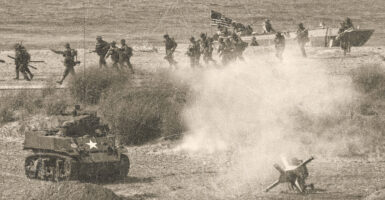Seventy-nine years ago this week, the Allies assaulted the Normandy beaches on D-Day, June 6, 1944.
Their invasion marked the largest amphibious landing since the Persians under Xerxes invaded the Greek mainland in 480 B.C.
Nearly 160,000 American, British, and Canadian soldiers stormed five beaches of Nazi-occupied France. The plan was to liberate Western Europe after four years of occupation, push into Germany, and end the Nazi regime.
Less than a year later, the Allies from the West, and the Soviet Russians from the East, did just that, utterly destroying Adolf Hitler’s Third Reich.
Ostensibly, the assault seemed impossible even to attempt.
Germany had repulsed, with heavy Canadian losses, an earlier Normandy raid at Dieppe in August 1942.
The Germans also knew roughly when the Allies were coming. They placed their best general, Erwin Rommel, in charge of the Normandy defenses.
The huge D-Day force required enormous supplies of arms and provisions just to get off the beaches. Yet the Allies had no means of capturing even one port on the nearby heavily fortified French coast.
To land so many troops so quickly, the Allies would have to ensure complete naval and air supremacy.
They would have to tow over from Britain their own ports, lay their own gasoline pipeline across the English Channel, and invent novel ships and armored vehicles just to get onto and over the beaches.
More dangerous still, the invaders would ensure armor and tactical air dominance to avoid being cut off, surrounded, and annihilated once they went inland.
German Panzer units—battle-hardened troops in frightening Panther and Tiger tanks, with over three hard years of fighting experience on the Eastern Front—were confident they could annihilate in a matter of days the outnumbered lightly armed invaders.
Such a huge force required 50 miles of landing space on the beaches. That vast expanse ensured that some landing sites were less than ideal—Omaha Beach in particular.
No one quite knows how many Allied soldiers, airmen, and sailors were lost during D-Day’s 24 hours.
Some 10,000 casualties is a good guess, including nearly 4,500 dead. Well over 400 soldiers were killed, wounded, or captured every hour of the first day.
Most of the losses occurred at Omaha Beach, the riskiest landing area. Cliffs there offered perfect German lines of fire onto the landing craft below.
Concrete seawalls blocked access from the beaches. Crack German troops had recently beefed up the fortifications. Mined hedgerows blocked entry into the countryside.
A tragic paradox of D-Day was that Omaha Beach proved an ungodly nightmare, while the other four landing sites worked like clockwork with few casualties.
Nearly a quarter-million Allied soldiers were killed or wounded in “Operation Overlord” over the ensuing seven weeks of fighting in Normandy. Combined German and Allied casualties exceeded 400,000. Nearly 20,000 French civilians were killed as “collateral” damage.
The Allies did not secure Normandy until the end of July, when they finally broke out into the plains of France and began racing toward Germany.
Intelligence failures, poor coordination between airborne and infantry troops, and mediocre leadership all plagued the Allies for most of June and July.
Yet the Allies pulled off the impossible by surprising the Germans, securing a beachhead, supplying that toehold in Western Europe, and then expanding the pocket into a vast 1,000-mile front that in less than a year shattered Hitler’s defenses.
How and why did the Americans on Omaha charge right off their landing craft into a hail of German machine gun and artillery fire, despite being mowed down in droves?
In a word, they “believed” in the United States.
That generation had emerged from the crushing poverty of the Great Depression to face the reality that the Axis powers wanted to destroy their civilization and their country.
They were confident in American know-how. They were convinced they were fighting for the right cause. They were not awed by traveling thousands of miles from home to face German technological wizardry, veterans with years of battle experience, and a ruthless martial code.
The men at Omaha did not believe America had to be perfect to be good—just far better than the alternative.
They understood, like their predecessors at Valley Forge, Gettysburg, and the Meuse-Argonne, that nothing in the United States was guaranteed.
They accepted that periodically some Americans—usually those in the prime of life with the greatest futures and the most to lose—would be asked to face certain death in nightmarish places like Omaha, in a B-17 over Berlin, or the horrid jungles in the Pacific.
The least our generation—affluent, leisured, and so often self-absorbed—can do is to remember who they were, what they did, and how much we owe them.
COPYRIGHT 2023 TRIBUNE CONTENT AGENCY LLC
The Daily Signal publishes a variety of perspectives. Nothing written here is to be construed as representing the views of The Heritage Foundation.
Have an opinion about this article? To sound off, please email letters@DailySignal.com and we’ll consider publishing your edited remarks in our regular “We Hear You” feature. Remember to include the url or headline of the article plus your name and town and/or state.

























